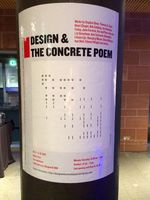Ampersands and
By Kate Sutherland
The symposium that I’m attending in Glasgow is part of a larger festival that has poetry popping up all over the city in various forms. Last night, I got to see some glorious visual manifestations in an exhibition on “Design and the Concrete Poem” at the Lighthouse. This exhibition brings together an extraordinary range of work, mostly from the 1950s through the 70s, much of it borrowed from private collections and hence rarely available for public viewing.
My favourite was a display of five large, orange ampersands suspended from a brick wall at the back of the gallery. These are from Stephen Bann’s Amber Sands, last shown on the lawn of the Brighton Royal Pavilion during a 1967 poetry festival. Other highlights for me included a coloured letterpress print by John Furnival titled Alpha, and various of the works made by Hansjörg Mayer in collaboration with other poets for a 1966 portfolio of Concrete Poetry in Britain, Canada and the United States of America.
Alongside the larger works, there were vitrines full of rare treasures, for example: an original copy of the Noigandres 4 Poesia Concreta folder, including the Pilot Plan for Concrete Poetry contained within (the Pilot Plan can be read here: http://www.ubu.com/papers/noigandres01.html); issues of the journal spirale edited by Eugen Gomringer, and of Pierre Garnier’s LES LETTRES; and a copy of Bob Cobbing’s poster for the Sound & Syntax International Festival of Sound Poetry held in Glasgow in 1978.
And there were many artifacts that showcase the links between the poets/artists such as letters from dom Sylvester Houédard and Stephen Bann to Hansjörg Mayer, works by John Furnival (two pop-up/kinetic poems and an unfolding Alphabet Vowel poem) published in Henri Chopin’s OU magazine, and a work by Eugen Gomringer (Silencio) published by John Furnival’s Openings Press imprint.
Curator Bronac Ferran was there to guide us round the entire exhibition, providing us with the benefit of her vast knowledge of and enormous enthusiasm for concrete poetry, and also offering up some interesting stories about how she managed to locate some of the items and, in some cases, how the collectors she borrowed them from had acquired them. Ferran’s description of the exhibition, along with photographs of some of the works included and quotations from interviews with some of the poets/artists can be accessed here: https://designandconcretepoem.wordpress.com/works/
Your CanLit News
Subscribe to Open Book’s newsletter to get local book events, literary content, writing tips, and more in your inbox
Some of my poems have recently taken a visual turn in a series exploring the history of navigation and maps, and I came away from the exhibition with my brain buzzing with new possibilities. And also, feeling determined to renew my letterpress adventures (about which more in a future post).
An addendum, thanks to my failure to get this post up last night: one of the artists included in the exhibition, Liliane Lijn, gave a talk at the symposium this morning, and I must direct you to her website to have a look at her extraordinary work. I was particularly taken with the “poem machines” she began making in the 1960s, so-called to get away from the preciousness she perceived to be associated with poetry, and designed to make poems move, to “return the energy to the written word.” See her poem machines and so much more here: http://www.lilianelijn.com/portfolio-item/alphabet-poem-machine-1962/
The views expressed in the Writer-in-Residence blogs are those held by the authors and do not necessarily reflect the views of Open Book.
Kate Sutherland was born in Scotland, grew up in Saskatchewan, and now lives in Toronto, where she is a professor at Osgoode Hall Law School. She is the author of two collections of short stories: Summer Reading (winner of a Saskatchewan Book Award for Best First Book) and All In Together Girls. How to Draw a Rhinoceros is Sutherland’s first collection of poems.
You can reach Kate throughout the month of October at writer@open-book.ca.


